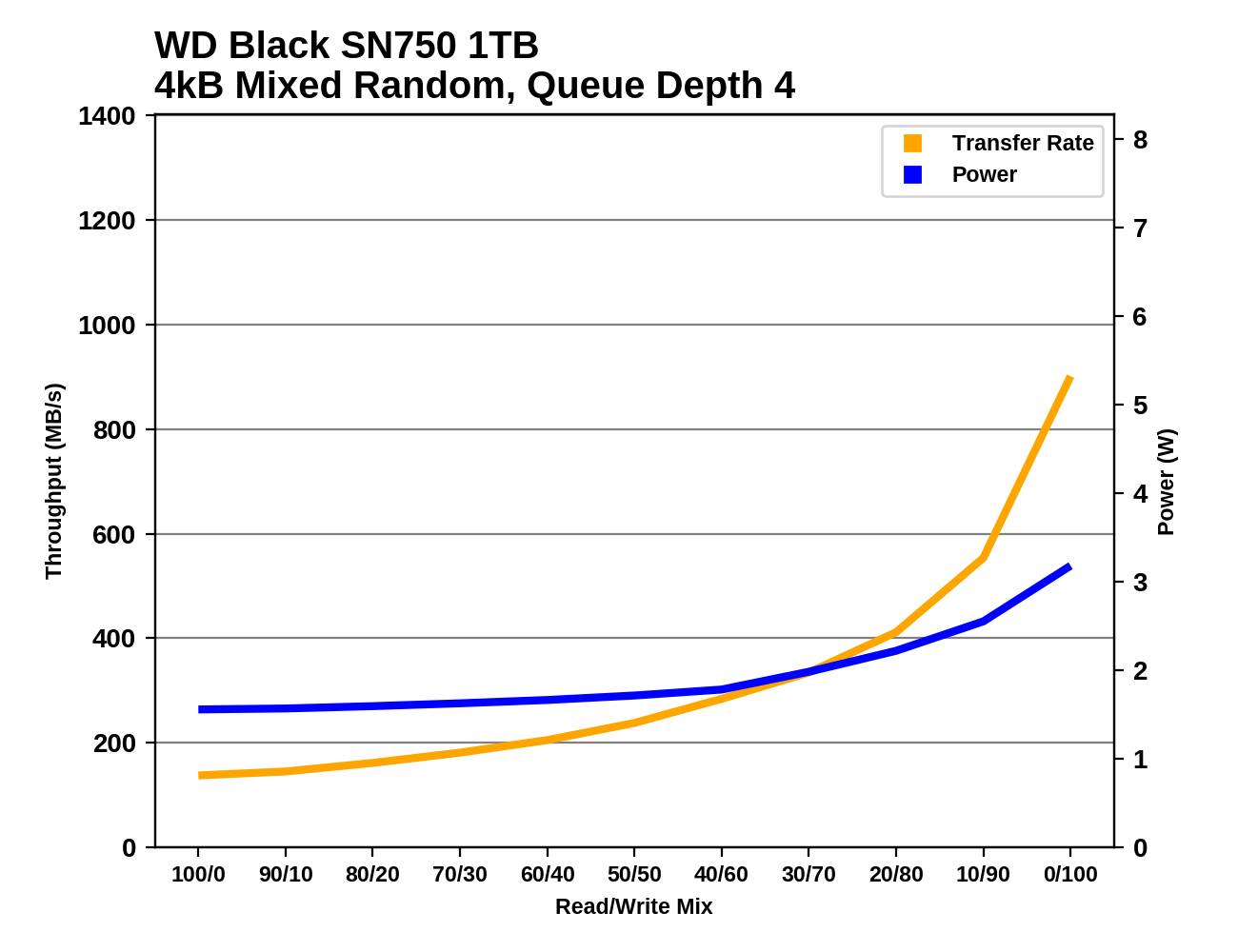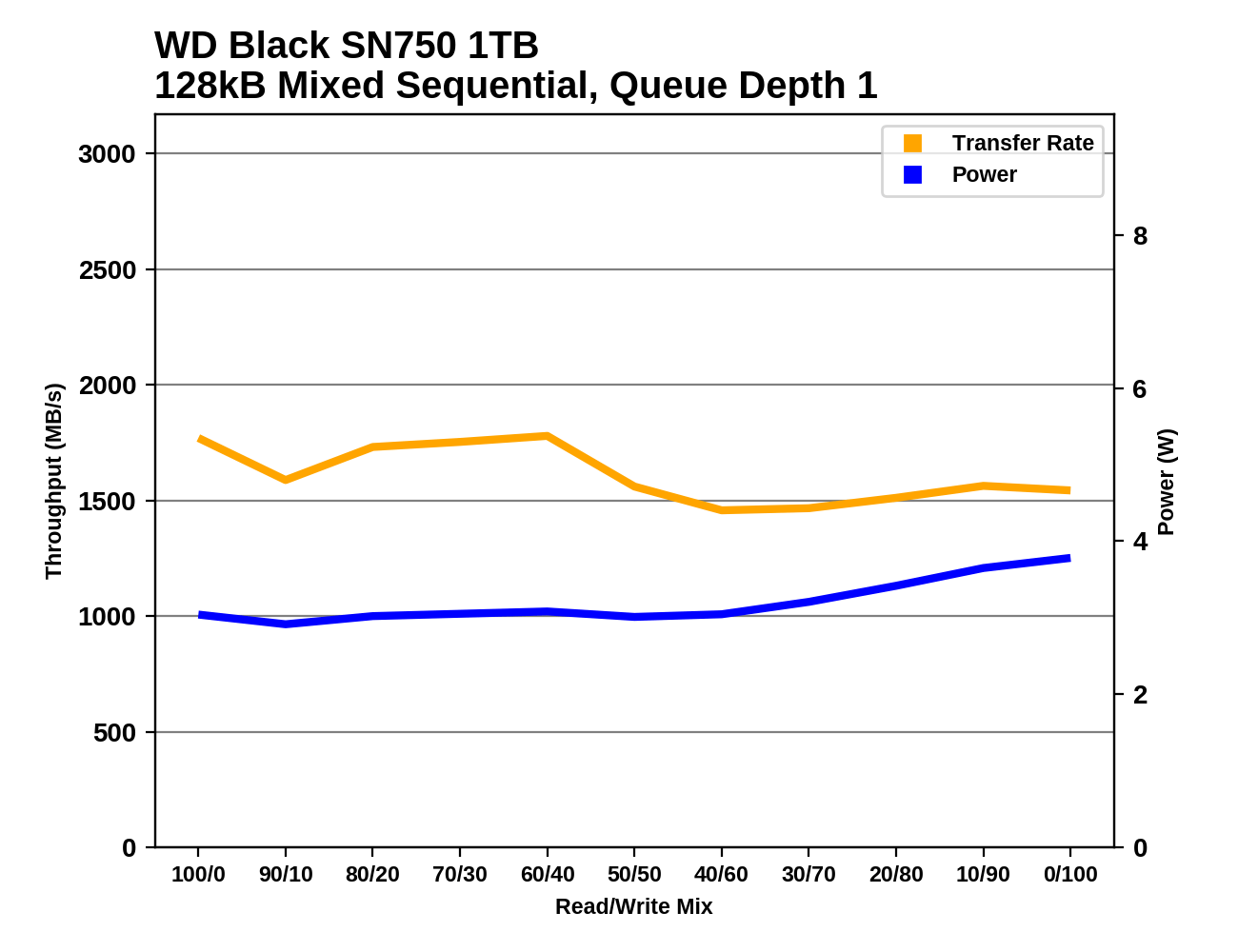The Western Digital WD Black SN750 SSD Review: Why Fix What Isn't Broken?
by Billy Tallis on January 18, 2019 8:01 AM ESTMixed Random Performance
Our test of mixed random reads and writes covers mixes varying from pure reads to pure writes at 10% increments. Each mix is tested for up to 1 minute or 32GB of data transferred. The test is conducted with a queue depth of 4, and is limited to a 64GB span of the drive. In between each mix, the drive is given idle time of up to one minute so that the overall duty cycle is 50%.

The overall mixed random IO performance of the Western Digital WD Black SN750 is about the same as the previous version, as well as the Toshiba XG6 and HP EX920. These are the second-tier drives that are a bit slower than the SM2262EN and the Samsung 970 EVO.
 |
|||||||||
| Power Efficiency in MB/s/W | Average Power in W | ||||||||
The SN750 and the Toshiba XG6 have almost exactly the same overall performance on this test, but the XG6 has 7% better performance per Watt. The second place score of the SN750 is still well above average—ignoring the outgoing WD Black, the SN750's performance per Watt is about 26% better than the next best TLC drive.
 |
|||||||||
The two flash-based drives that substantially outperform the SN750 on the mixed random IO test are faster through almost all of the test's phases, while the drives that are roughly tied with the SN750 tend to be a bit faster through the more read-heavy parts of the test and fall behind when the workload becomes very write-heavy.
Mixed Sequential Performance
Our test of mixed sequential reads and writes differs from the mixed random I/O test by performing 128kB sequential accesses rather than 4kB accesses at random locations, and the sequential test is conducted at queue depth 1. The range of mixes tested is the same, and the timing and limits on data transfers are also the same as above.

The WD Black SN750 improves upon its predecessor's performance on the mixed sequential IO test, but not quit enough to take the top spot on the performance ranking. The Samsung 970 EVO is a few percent faster overall.
 |
|||||||||
| Power Efficiency in MB/s/W | Average Power in W | ||||||||
The SN750 has a clear lead in the efficiency scores, improving upon the previous record set by last year's model that remained largely unchallenged, though the Toshiba XG6 and Corsair MP510 did come close. The average power consumption of the SN750 is slightly higher than the previous WD Black but that is more than offset by the higher average performance.
 |
|||||||||
The WD Black SN750 only barely drops below 1.5GB/s at its worst during the mixed sequential IO test, and it performs a bit better during the more read-heavy half of the test. The other drives all have worst-case performance that's slower than the SN750 by at least a few hundred MB/s, but many of those drives also have significantly better peak performance, most often at the read-heavy end of the test.










54 Comments
View All Comments
Oxford Guy - Monday, January 21, 2019 - link
It's weird to review minor products and not review something major like the GTX 960.It may be explainable without conspiracy but it's still weird, in terms of priorities.
Alistair - Friday, January 18, 2019 - link
Can't wait to read the SX8200 Pro review. I've bought a few, and I believe they are the best performing drives for the money right now. Excellent. I stopped buying Samsung after they started denying warranties in Canada (and they don't seem to want to fix that). Anyways the Samsung drives cost almost twice the SX8200 pro and perform exactly the same pretty much. Maybe the SX8200 Pro is even faster than the 970 EVO honestly.gglaw - Friday, January 18, 2019 - link
A few from decent reviewers are already up for this and the HP EX950 which are small upgrades over the incredibly well-rounded drives they replaced. The SX8200 (non-pro) and EX920 go on so many massive sales it is hard to beat them until the newer drives start dropping in price. The average home user would never know whether they had a 970 Pro, SX8200, SX8200 Pro, or EX950 running so major price differences would make the decision for me. After my initial experiences with the SX8200/EX920, these have been all I've stocked for close to a year. Made me almost regret my 970 Pro. They regularly go on sale for ~$75 for 500GB, and $135 for 1TB versions so my SSD adventures have become rather boring with no close 2nd place I would even consider buying.I'm likely going to get a SX8200 Pro just because I can't help myself with new versions of my favorite drives, but I'm already 99% positive I'll be in the same boat of not being able to tell any difference with the small upgrade. Then I'll have buyer's remorse again like the 970 Pro, knowing the 1TB version of the cheaper drive is barely more than the new 500GB one (SX8200 1TB $135, Pro 500GB $115).
ajp_anton - Friday, January 18, 2019 - link
What's wrong with WD's idle power consumption, and am I right assuming that that makes it unsuitable for laptops (mobile ones, not gaming)?Billy Tallis - Friday, January 18, 2019 - link
We test SSDs on a desktop, and that means we need to jump through some hoops to get PCIe power management enabled. I've never encountered a desktop motherboard that even has PCIe ASPM enabled by default, and when you are lucky enough to get a BIOS option to turn it on, you can't trust that to take care of everything. Even with the OS set to override the motherboard's settings, not all drives are able to enter their deepest sleep state on our testbed.I view this situation as being similar to DEVSLEEP for SATA drives. It's pretty likely that a laptop which was designed to use M.2 PCIe storage will have all the right firmware bits enabled to use the deepest power saving modes, but they're normally not used (or usable) on a desktop and I don't currently have equipment that can work around that.
hnlog - Saturday, January 19, 2019 - link
WD Black NVMe has problem on Linux with default parameter.Is it fixed on the new model?
https://community.wd.com/t/linux-support-for-wd-bl...
I think WD should test before shipping the former model.
Billy Tallis - Monday, January 21, 2019 - link
Basically every NVMe SSD vendor has shipped something that turned out to have serious power management bugs, most often with APST and only on certain host systems. It's pretty clear that no vendors (SSD or motherboard) are thoroughly testing those features before shipping, and instead just make sure that it works with a small handful of Windows configurations. But even the Windows NVMe driver is a moving target and new builds have caused problems.It would probably help if the UNH-IOL NVMe Integrator's List testing included APST, but their current test plan only checks whether the drive can handle manually setting power states. And even if they were more thorough, only a few vendors put consumer drives through that certification.
FXi - Sunday, January 20, 2019 - link
I wonder when we'll see the upper end of sizes in consumer drives jump to 4TB. Durability seems to be ready. Perhaps consumer need isn't quite there. But if controllers can handle it and layers exist for it to be built to that size in the M2 format, you'd think that's where they would go next since prices have come out of the stratosphere.eastcoast_pete - Sunday, January 20, 2019 - link
Is it just me, or do these comparisons make the HP 920 look quite good? Not in terms of top performance, but in performance/price. Has anybody here had any experiences with 920 drives?piasabird - Sunday, January 20, 2019 - link
Why not compare similar products together? Why is one drive a 2 TB drive? Since 2TB has more save locations it may naturally be faster due to drive space, cache size, energy usage, etc. Maybe Anandtech doesnt use samsung drives because Samsung will not donate the drives for free but other companies would give them free gear to test.